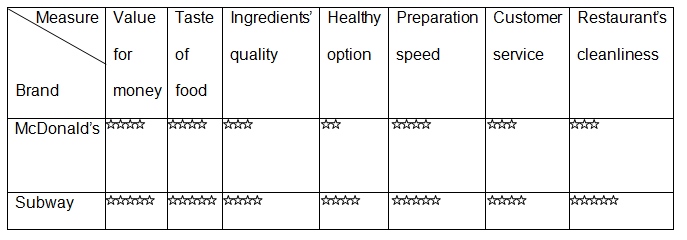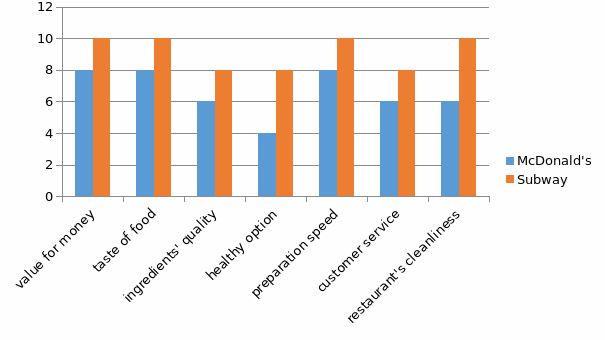Introduction
The ability of consumers to identify, describe and differentiate a specific brand from its competition is at the center of all branding initiatives carried out by different branding managers as they try to improve their brand awareness levels. This paper shall set out to discuss the importance of brand awareness by conducting a case study that compares two brands in Australia.
This shall be done by highlighting the importance of brand awareness, comparing the breadth and depth of brand awareness for the chosen products and analyzing the results from the survey conducted in a bid to measure the level of brand awareness each product has in the Australian market.
Importance of brand awareness
According to Atiglan et al. (2009), brand awareness refers to the likelihood that consumers within a given market know of the existence and availability of a given product. Atiglan et al. (2009) further state that brand awareness is the degree of precision to which consumers link a brand to a specific product. Effective brand awareness is measured from the consumers’ ability to recognize or recall a specific brand.
Similarly, Srivastava (2009) argues that branding efforts become futile if the product does not satisfy the needs of the targeted consumers. As such, the author states that brand managers should come up with brands that consumers can identify with in regard to the product’s performance, applicability and imagery.
With this in mind, it is always important for brand managers to measure the brand awareness level of their brands in order to reap the learning, consideration and choice advantages.
Keller (2008), states that effective brand awareness ensures that the brand is registered in the consumer’s mind. This means that a consumer is able to easily recognize and recall a brand amidst other competing brands.
In addition, brand awareness increases the probability that consumers will consider a specific brand and choose it when faced with options. As such, measuring the brand awareness level of a given brand is important to brand managers because it enables them to market and improve their brands in a manner that guarantees consumer satisfaction and loyalty.
Breadth and Depth of Brand Awareness: Sample Description
According to Keller (2008), the depth of brand awareness refers to the ease of recognition and recall and how strong the brand is categorized among competing brands. The breadth of brand awareness deals with the purchase and consumption considerations made by the consumer when choosing a specific brand.
In order to measure these dimensions, a case study was conducted in a bid to establish the overall consumer satisfaction rating of two prominent quick service restaurants in Australia. McDonald’s restaurants and Subway restaurants were chosen and ten respondents selected to participate in the survey.
Eating fast and maintain a healthy life style were the main considerations made by consumers frequenting quick service restaurants. This is according to results posted by respondents to a survey recently conducted in Australia. Age, gender and career choice played a pivotal role in determining the type of food consumers ordered.
In regard to brand recognition, most people stated that they knew McDonalds and have had their meals. They attributed this to the fact that McDonalds is prominent, familiar and popular as compared to other brands. However, when asked of their satisfaction rating, most participants recalled that subway restaurants offered the best services in terms of price, quality of service and interactivity.
Research method
A qualitative research methodology was selected for this study. The primary method of data collection was a survey. A semi-structured interview was conducted with the selected respondents and the results compiled and analyzed graphically.
Table 1: selection criteria of respondents
This research method was selected due to its flexibility and its ability to give credible and computable results. In addition, it enabled the researcher to observe and interact with the respondents freely without inconveniencing their schedules. Out of the five male respondents, two were aged below 25 years old. Three of the female respondents were below 25 years old.
The logic behind this classification is because younger females are more conscious about their looks as compared to their older counterparts. On the other hand, older males are health conscious and try to live health lives. This criterion was effective since it was designed to evaluate the level of brand awareness of the selected brands in regard to consumer satisfaction.
Measures
The respondents were required to rate their satisfaction levels from the selected brands based on predefined parameters. The rating method was based on a scale of 1-5 stars, 1 star being the lowest score and 5 stars being the best score. These two restaurants were selected due to their market share and availability across the Australian market. Below is an overall presentation of the results posted from the survey.

Research results
As mentioned earlier brand salience focuses on the ability of the brand to create a lasting impression on the consumer mind.
The results from the survey indicated that while McDonald’s is a renowned brand in Australia, its brand awareness level is lower in comparison to the levels exhibited by subway restaurants, which are higher. The graph below shows the relationship between the respondents and their responses on the selected measures.
Graph 1: respondents and response to brand awareness Measures

From the graph it is evident that the brand awareness levels of Subway restaurants are higher than those recorded for McDonald’s restaurants. This can be attributed to the fact that Subway restaurants have marketed their brands more effectively in terms of consumer satisfaction, quality of service and the ability of consumers to identify themselves with Subway’s products.
For example, in their website, Subway restaurants offer their consumers a chance to develop a unique recipe for their meals. This is a marketing strategy that ensures that consumers have a sense of ownership to this brand, thereby guaranteeing their loyalty.
In addition, subway’s emphasis on fresh and healthy products attracts more consumers. This ensures that their products are recognized, considered and chosen by consumers.
On the other hand, McDonald has failed to address the key issues that may make their brand more prominent. By providing less quality products, McDonald’s has given Subway restaurants a competitive edge that remains unmatched in the Australian market.
Data analysis
Data analysis was categorized according to the drinks, breakfast and meal preference of the respondents as can be seen in appendix 1. In regard to drinks, McDonald’s brands were preferred by most of the respondents.
Subway restaurant meals and breakfasts were preferred by all respondents due to the fact that they are healthier options in comparison to those served at McDonald’s restaurants. Below is a table showing a breakdown of brand preferences recorded by respondents
The table above shows the number of respondents who could recognize and recall various products from the selected brands. From the results, it is evident that the depth of brand awareness for Subway brand products is higher than that of McDonald’s brand products.
Conclusion
Brand awareness provides brand managers with an avenue through which they can effectively market their products in a competitive business environment. By ensuring that a brand is easily recognized, recalled and considered, businesses guarantee their survival, all the while increasing consumer loyalty.
From this report, it is evident that brand awareness plays a pivotal role in marketing and it should be effectively implemented if success is to be achieved.
References
Atiglan, E, Akinci, S, Aksoy, S & Kaynak, E 2009, ‘Customer-Based Brand Equity for Global Brands: A Multinational Approach’, Journal of Euromarketing, vol. 18, no. 2, pp.115-132.
Keller, KL 2008, Strategic brand management – building, measuring and managing brand equity, international edition, 3rd edn, Prentice Hall, New Jersey.
Srivastava, RK 2009, ‘Measuring brand strategy: can brand equity and brand score be a tool to measure the effectiveness of strategy?’, Journal of Strategic Marketing, vol. 17, no. 6, pp. 487-497.
Appendix
Compiling results for depth of brand awareness